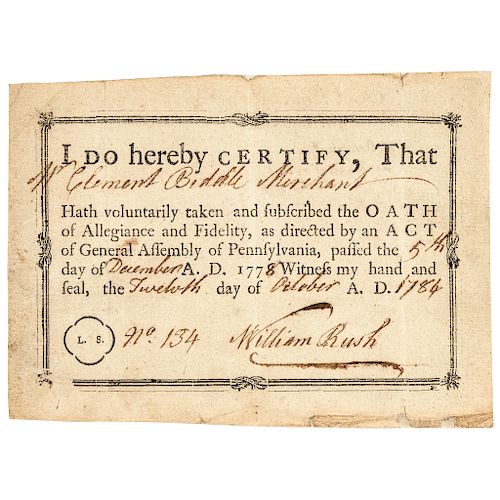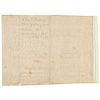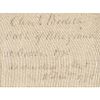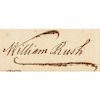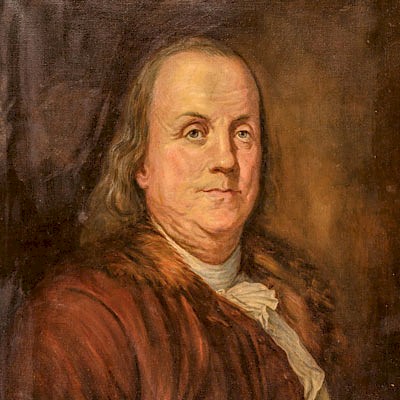1778 Signed PA. Oath of Allegiance and Fidelity by Act Passed December 5th, 1778
Lot 7
Estimate:
$1,000 - $3,000
Absentee vs Live bid
Two ways to bid:
- Leave a max absentee bid and the platform will bid on your behalf up to your maximum bid during the live auction.
- Bid live during the auction and your bids will be submitted real-time to the auctioneer.
Bid Increments
| Price | Bid Increment |
|---|---|
| $0 | $10 |
| $200 | $20 |
| $300 | $25 |
| $500 | $50 |
| $1,000 | $100 |
| $2,000 | $200 |
| $3,000 | $250 |
| $5,000 | $500 |
| $10,000 | $1,000 |
| $20,000 | $2,000 |
| $30,000 | $2,500 |
| $50,000 | $5,000 |
| $100,000 | $10,000 |
| $200,000 | $20,000 |
| $300,000 | $25,000 |
| $500,000 | $50,000 |
About Auction
By Early American History Auctions
Aug 24, 2019
Set Reminder
2019-08-24 12:00:00
2019-08-24 12:00:00
America/New_York
Bidsquare
Bidsquare : Autographs, Colonial Currency, Political Americana, Historic Guns
https://www.bidsquare.com/auctions/early-american-history-auctions/autographs-colonial-currency-political-americana-historic-guns-4347
Historic Autographs • Colonial Currency • American Civil War Colonial Era • Revolutionary War • Political Americana • Black History Early American History Auctions auctions@earlyamerican.com
Historic Autographs • Colonial Currency • American Civil War Colonial Era • Revolutionary War • Political Americana • Black History Early American History Auctions auctions@earlyamerican.com
- Lot Description
Autographs
1780 "Clement Biddle Merchant" His Sworn Pennsylvania "Oath of Allegiance and Fidelity" by Act of December A.D. 1778 Historic Document Signed as being Witness by "William Rush" Famous as America's First Native-Born Sculptor
(CLEMENT BIDDLE) - Made To: (1740 - 1814) American Revolutionary War General who crossed the Delaware on Christmas night in 1776, eventually promoted to General under George Washington's command at Valley Forge and the First Federal Marshal in Pennsylvania 1789. WILLIAM RUSH - Signed: (1756 - 1833) The First Major Native-born American Sculptor.
October 12, 1780-Dated Revolutionary War Era, Partially-Printed Document Signed, "William Rush", Oath of Allegiance and Fidelity, for "Clement Biddle Merchant," by Act of the General Assembly, passed the 5th day of December A.D. 1778", Pennsylvania, Choice Very Fine. A very rare and historically important nice quality original "Oath of Allegiance and Fidelity" Form completed October 12th, 1780, where "Clement Biddle" (1740 - 1814) a personal Aide to Revolutionary War American Major General Greene and to General George Washington, and a Merchant of Philadelphia, Appointed the First U.S. Marshall (1789-1793) for Pennsylvania by President George Washington, has taken his Sworn Oath, according to the Act of 1778. This Oath being Sworn to by Clement Biddle in the presence of and Signed by "William Rush" (See: The book titled: "William Rush, 1756-1833: The First Native(-born) American Sculptor," Paperback, 1937 by Henri Marceau (Author).
Loyalty Oaths such as these were often given to men of the local militia companies and white male citizens. This example is quite extraordinary and is the actual original fully issued Oath, on its fully completed printed form. It has large full marhins with excellent centering. The form measures about 5.75" wide x 4.25" tall, its blank reverse side has been silked for preservation to reinforce some small outer edge splits. The boldly printed black text completed with rich brown ink manuscript portions and signature are on very clean watermarked period laid paper. The year 1780 of the Oath has a somewhat blundered "0" on its face, appearing like a "4". However, the docket on the blank reverse is able to be read, in full: "Clemt. Biddle / Oath of Allegiance / 12 October 1780 / as directed by Act / 5 Decr. 1778". Overall, this historic Oath for none other than the Patriot "Clement Biddle Merchant" has choice eye appeal and in very nice condition for display.
On December 5th, 1778, an Act of Assembly was passed, where by all white male citizens (with certain exceptions) were require to take an Oath of Allegiance to the State of Pennsylvania. Commissioners were appointed in all counties of the State, to administer the oath, and blanks of Printed Forms were supplied to them for use in the performance of that duty. This is one such completed "Oath" form.
Clement Biddle (1740 - 1814). Unlike most of the Generals who held command under General Washington, Clement Biddle was not what would have been, by the standards of the day, an educated man. Born in Philadelphia on May 10th, 1740, Biddle was the child of Quakers John Biddle and Sarah Owen. Not much is known about his early years, as his family did not hold a prominent place in Quaker life in Pennsylvania. Biddle is not known to have completed any education past the primary level, but he was a prominent part of his father's shipping business before the onset of the American Revolution.
Before the Revolution, Biddle organized one of the first fighting units of Quakers in the United States, known as the "Quaker Blues". Despite the normal pacifist vows of the Quaker faith, the Blues, under Biddle's leadership, carried out several successful campaigns before the start of the war, including aiding friendly Native Americans in their resistance against the infamous "Paxton Boys." A vow taken in 1765, in relation to the non-importation movement, would lead to Biddle being a key military figure in the Revolutionary War.
At the onset of hostilities, Biddle, after organizing another regiment of Quakers, was given the position of deputy Quartermaster of the 10,000 member "flying camp", one of the earliest volunteer regiments of the Revolutionary War. As such, he engaged in the battles of Trenton, Brandywine, Germantown, and Monmouth. Trenton is of particular note, as it was the small, but important battle that General Washington won by crossing the Delaware on Christmas night in 1776, giving the rebels the key element of surprise. Eventually, Biddle was promoted to General under Washington's command at Valley Forge.
Although Biddle was content to retire from active service in 1780, his former commander and friend was not apt to allow him to retire to the life of a merchant, as he intended. Through the later years of the war, Biddle served as quartermaster general for the Pennsylvania militia.
President George Washington appointed Biddle to the head of the United States Marshals in 1789; in fact, Biddle holds the distinction of being the first Marshal in Pennsylvania's history. The job of Marshal, however, was not one that Biddle particular enjoyed. He was quick to beg off his duties because of bad health. In one case, he refused to arrest a pair of bandits at the behest of Secretary of State Thomas Jefferson due to a case of gout. Before the end of Washington's term, he wrote the president, asking him to not re-appoint him to the post. In his letter, Biddle states that:
"I determined, however, to contribute all in my power to the support of the Government of the United States, to execute the Office during the period to which you do me the honor to appoint me and I have endeavored to execute it with fidelity and to merit the Confidence you were pleased to place in me; but I find that the Expense attending the Execution has been equal to or greater than the Endowments of the office and the hazard and Responsibility attending the same and so great that I cannot think myself justified in continuing to hold the Office."
Outside the bounds of governance, Washington and Biddle still carried on a friendly relationship of mutual respect. Their correspondence was often mundane, with this example of Washington requesting Biddle request in procuring a housekeeper an example: "The inclosed is to Edward (I do not know his Surname) who formerly lived with Mr R. Morris, but now, I am informed, keeps the City Tavern, to see if he can be instrumental in procuring me a House keeper. I beg you to be so obliging as to direct, deliver, and consult him on the contents of the letter, which is left open for your perusal, & return me an answr as soon as possible."
While Biddle himself passed away on July 14th, 1814, he left behind a legacy of 13 children, including his namesake, who would serve in the United States Army during the War of 1812 before rising to a prominent position as a banker in Philadelphia. However, it is his grandson of the same name that would honor the family's place in history. A graduate of The University of Pennsylvania, the third Clement Biddle would honor his family history with George Washington in a poem, published in 1873, entitled "Valley Forge".
"On that long, sloping pasture ground
The lines of old redoubts are found
For there in those disastrous days,
When Victory's sun concealed his rays
And Hope, alone, the strength supplied
Still to sustain the nation's pride:
Wearied and wasted, in that day
Our suffering, half-starved army lay
On that hill side, through winter rude
Watched over by the great, the good
The Immortal Washington, who stood
The unmoved bulwark to our foes..."
M. Earl Smith
University of Pennsylvania
_____
William Rush (1756 - 1833) is considered to be the First Major American Sculptor.
He trained in his profession on carving wooden Ships' figureheads, including four of the original six frigates of the US Navy, the USS "United States" ("Genius of the United States" 1796), USS "Constellation" ("Nature" 1797), USS "Chesapeake" ("Revolution" 1799), and USS "Congress" ("Goddess of Wisdom" 1799). He designed the figurehead for a fifth original frigate, USS "Constitution" ("Hercules" 1796), carved by John Skillin, and possibly a sixth, USS "President" ("George Washington" 1800), carved by his apprentice Daniel N. Train.
Additionally, he carved figureheads for the US Navy frigates USS "John Adams" ("John Adams" 1799), USS "Philadelphia" ("Hercules" 1799), and USS "Potomac" ("Captain John Smith" 1822), along with the gun-ships USS "Franklin" ("Benjamin Franklin" 1815), USS "Columbus" ("Christopher Columbus" 1819), USS "North Carolina" ("Sir Walter Raleigh" 1820) and USS "Pennsylvania" ("Hercules" 1824 to 1837, attributed to him or his son John Rush). He was one of the first sculptors in the US to create an outdoor public sculpture.
His twin figures, "Comedy" and "Tragedy" (1808) were originally installed in niches on the faade of Philadelphia's Chestnut Street Theater and his "Water Nymph and Bittern" (1809) was created as a fountain sculpture for the Center Square Waterworks, which stood at what is now the site of the Philadelphia City Hall. In 1810, he carved a life-sized statue of the "Crucifixion" for St Augustine's Church which was destroyed in 1844 when the church was burned during Philadelphia's anti-Catholic riots. His life-sized statue "George Washington" (1815), which was originally exhibited at Independence Hall in Philadelphia, is now at the Second Bank of the United States. He carved a self-portrait bust in 1822 at the age of 66 that is housed in the Pennsylvania Academy of Fine Arts, which he and his friend and fellow artist Charles Wilson Peale helped to establish in 1805. His sculpture "Wisdom and Justice" (1824) adorned a triumphal arch that was erected in front of Independence Hall for the visit of the Marquis de Lafayette. Additionally, he carved a portrait bust of Lafayette during his 8-day visit. He carved the allegorical figures "The Schuylkill Chained" and "The Waterworks" in 1825 which were installed on top of pavilions along the Schuylkill River. Both of these pieces now reside at the Philadelphia Museum of Art, along with the majority of other carvings that he made during his lifetime. Other collections of his works are exhibited at the Philadelphia Masonic Temple, the Library Company of Philadelphia, the American Philosophical Society, the Independence Seaport Museum, the Yale University Art Gallery, and the American Revolution Center. All but one of his earlier wooden figurehead ship carvings for US Navy vessels have either been lost or destroyed.
Bio by: William Bjornstad
- Shipping Info
-
Early American provides in-house worldwide shipping. Please contact us directly if you have questions about your specific shipping requirements.
-
- Buyer's Premium



 EUR
EUR CAD
CAD AUD
AUD GBP
GBP MXN
MXN HKD
HKD CNY
CNY MYR
MYR SEK
SEK SGD
SGD CHF
CHF THB
THB